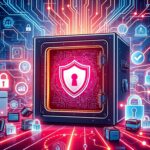Did you know that nearly all IT leaders agree that certified staff add an average value exceeding $30,000 a year to their organizations? In today’s fast-paced digital landscape, mastering Identity and Access Management (IAM) is key. CISSP Domain 5 focuses on this, highlighting the importance of secure access controls and proper user identity management.
By implementing strong IAM practices, organizations can make sure only authorized people access sensitive resources. This protects the integrity and confidentiality of data.
This domain covers everything from developing secure authentication mechanisms to following critical regulations. As you explore IAM in CISSP Domain 5, you’ll see how these elements work together. They help reduce risks and improve your organization’s security in a complex threat environment.
Key Takeaways
- CISSP Domain 5 focuses on essential Identity and Access Management practices.
- Secure authentication mechanisms are vital for organizational safety.
- IAM ensures only authorized users access sensitive resources.
- Compliance with regulations is a critical aspect of IAM.
- Effective IAM practices mitigate risks in digital environments.
Understanding Identity & Access Management (IAM)
Identity and Access Management (IAM) is key to keeping information safe in companies. It makes sure only the right people can see and use important data and systems. This means figuring out how to make, manage, and check user identities is very important.
Companies need to set up good access controls. These controls decide who can see certain things and when. It’s all about keeping things secure.
Definition of IAM
IAM is about managing user identities and controlling access to company resources. It uses authentication mechanisms to check who is who. This keeps things safe.
Using role-based access controls is also smart. It matches user permissions with their job roles. This makes things more secure and easier to manage.
Regularly checking and reviewing access is also crucial. It helps spot and fix any problems with who can see what. Knowing IAM well helps create a strong system for keeping data safe. It makes sure the right people have access without risking security.
Importance of IAM in Information Security Governance
Identity and Access Management (IAM) is key in information security governance. It helps manage risks of unauthorized access to sensitive data. Without good IAM, data breaches can happen, causing financial loss and harming your reputation.
It’s important to understand how IAM helps manage risks. Strong IAM systems help identify, authenticate, and authorize users. This makes sure only the right people can access data.
Compliance management also ties closely to IAM. Many rules require strict IAM to protect data. Following these rules helps keep data safe and builds trust in your organization.
In short, IAM is more than just a technical need. It’s a core part of keeping data safe and following rules. Make sure to invest in strong IAM to protect your organization from threats.
Key Components of CISSP Domain 5
CISSP Domain 5 is all about the key parts of IAM. These parts are crucial for keeping information safe. They help organizations set up strong security controls and better verify identities.
User provisioning is a big deal. It’s about making and managing user accounts and giving them the right access. It’s the base for good security in a company.
Authentication is key to knowing who’s really there. Using multi-factor authentication makes things even safer. It checks several things before letting someone in.
Access controls limit what users can do with sensitive info. They follow set rules. This makes sure only the right people can see certain data, keeping it safe.
Regular audits are important too. They check if everything is following the rules and spot any weak spots. This helps make the company’s security even stronger.
| IAM Component | Description |
|---|---|
| User Provisioning | The process of creating, managing, and deactivating user accounts while ensuring that access rights are properly assigned. |
| Authentication Mechanisms | Methods used to verify a user’s identity, including single sign-on and multi-factor authentication. |
| Access Controls | Policies and rules that define who can access what data, helping to restrict sensitive information to authorized users. |
| Auditing | Regular examination of access logs and user activities to ensure compliance and identify vulnerabilities. |
CISSP Domain 5: Security Policy Management
Security policy management is key in CISSP Domain 5. It deals with making, enforcing, and checking security policies. These policies tell users what to do and what not to do. They also say what happens if someone breaks the rules.
Good security policies need a strong governance framework. This framework ties policies to the company’s goals. Without it, even the best policies might not work as they should.
Effective security policy management includes:
- Defining clear roles and responsibilities
- Regularly reviewing and updating security policies
- Training employees on security expectations and procedures
- Implementing monitoring mechanisms to ensure adherence to IAM policies
The job market is showing more interest in security policy management. There are over 3,000 jobs in this area, with 60 companies looking for people. This shows how important it is to know about security policies and IAM policies.
It’s crucial to keep a good governance framework. This helps not just in making policies but also in checking if they work. By following professional standards, companies can build a secure culture that helps their goals.
| Job Category | Number of Openings | Average Salary Range |
|---|---|---|
| Cyber Data Science Engineer | 3,084 | USD 147,000 – USD 274,000 |
When you work on security policy management, remember the high standards. You need a lot of experience and education. This shows how important a strong governance framework is for good IAM policies.
CISSP Domain 5: Identity Access Management Lifecycle
The IAM lifecycle is key to keeping user accounts safe and managing identities well. It covers the whole life of a user’s identity, from when it’s first made to when it’s deleted. Each step is vital for a secure place where only the right people can see sensitive information.
At the start, new accounts are set up with the right access based on their role. This ensures each user has the right to do their job. Then, access is checked often to make sure it still fits with the user’s role. This should happen at least X times a month.
Finally, access is taken away when someone leaves the company. It’s important to remove access quickly, within X hours after someone leaves. This helps keep the company safe from security threats.
Organizations use many tools to make the IAM lifecycle better. For example, role-based access control is used for X% of access levels. This means users only get the access they need. Also, multi-factor authentication is used for X% of login attempts to make logins safer. Regular audits help keep access practices healthy.
Keeping identity governance strong is crucial for following rules and avoiding security problems. Companies that focus on the IAM lifecycle are more likely to protect themselves from security breaches and keep their important data safe.
Compliance Management and Its Role in IAM
Compliance management is key in Identity and Access Management (IAM). Companies must follow many rules about how they handle user data. This ensures data safety, which builds trust and protects the company’s image.
Using IAM solutions helps meet rules like GDPR and HIPAA. It automates who can access what and watches user actions. This keeps data safe and lowers the chance of breaches. Regular checks are needed to make sure everything is up to date.
In cybersecurity, those who focus on compliance can earn good salaries. For example, Cyber Data Science Engineer jobs in Springfield, VA, pay between USD 147K and USD 274K. These jobs require skills like:
- U.S. Government Top Secret clearance with SCI eligibility
- DoD 8570 certification in IAT or IAM
- Experience with data visualization tools like Tableau or Infogram
- Familiarity with the Risk Management Framework (RMF) process
- Strong communication skills, both verbal and non-verbal
Also, cybersecurity focuses a lot on following rules, with about 17.6% of jobs doing this. With more people working from home, 23.5% of these jobs are remote, 29.4% are hybrid, and 47.1% are on-site.
By linking compliance management with IAM, security gets better. It also keeps user data safe and follows the law and ethics.

| Position | Salary Range (USD) | Remote/Hybrid/On-site |
|---|---|---|
| Cyber Data Science Engineer | 147K – 274K | Remote/Hybrid/On-site |
| Cyber Security Specialist | 120K – 250K | Hybrid |
| Data Loss Prevention Analyst | 85K – 130K | On-site |
Risk Management in Identity & Access Management
Effective risk management is key in Identity & Access Management (IAM). It helps spot and check security risks when users access sensitive data. With strong access control, companies can lower the risk to their digital assets.
Key strategies for better risk management include:
- Strong authentication methods: Using multi-factor authentication (MFA) cuts down on unauthorized access.
- Regular risk assessments: Doing these assessments keeps companies aware of vulnerabilities and helps them adjust.
- Data encryption: Encrypting data at rest and in transit adds another layer of security against breaches.
About 42.8% of cybersecurity jobs focus on risk management. This shows the need for experts in this field. In places like New York, those with certifications like CompTIA Security+ get good pay. This highlights the importance of risk management skills in IAM.
By being proactive in risk management, your organization can keep its access control strong against new threats. This ongoing effort not only keeps security high but also meets regulatory needs.
Benefits of Implementing Effective IAM Controls
Effective IAM controls bring many benefits. They improve security and protect data. By using strong IAM policies, companies can lower the chance of data breaches. This builds trust with customers and other stakeholders.

- Improved Data Protection: IAM controls make sure only the right people see sensitive info. This cuts down on data leaks.
- Enhanced Compliance: Companies follow rules better with IAM. This lowers legal risks from handling data.
- Increased Operational Efficiency: IAM automates tasks. This lets IT teams focus on big projects.
- Trust and Reputation: A good IAM system builds customer trust. This leads to stronger relationships and loyalty.
Adding IAM to business operations boosts security. It also helps manage access better. As cyber threats get more complex, using IAM is key for strong security.
| Benefit | Description |
|---|---|
| Data Protection | Restricts access to sensitive data, reducing leak risks. |
| Compliance | Aids in meeting regulatory standards, mitigating legal issues. |
| Operational Efficiency | Automates access processes, freeing up IT resources. |
| Reputation | Enhances trust and loyalty among customers and stakeholders. |
Using effective IAM controls is a smart move. It helps protect against new threats and makes operations smoother.
Conclusion
CISSP Domain 5 plays a big role in an organization’s security. It uses Identity and Access Management (IAM) to keep data safe. This practice also meets legal requirements.
Having a strong IAM strategy helps protect against threats. It also builds trust and accountability in your team. This is key for a secure environment.
Creating a good IAM plan means always learning and updating. Cybersecurity experts should get certifications like CISSP. These cover important areas.
Staying current with new threats is crucial. It lets you use the best security methods. This keeps your organization safe from cyber threats.
| Certification | Focus Area | Cost |
|---|---|---|
| CISSP | Broad cybersecurity domains | Varies (often around $1000) |
| CompTIA Security+ | Fundamental security practices | Approximately $400 |
| CEH | Ethical hacking techniques | Around $1000 |
| CISM | Information security management | About $750 |
| CLOUD (CCSP) | Cloud security practices | Approximately $600 |
Investing in IAM and training is smart. It prepares you for tough cybersecurity jobs. It also keeps your organization’s data safe.
Each certification has its own benefits. They cover different security areas. This makes you a key player in your organization’s security plan.
Final Thoughts on CISSP Domain 5
Adding CISSP Domain 5 to your security plan is key to fight cyber threats. It helps understand Identity and Access Management (IAM) well. This knowledge boosts your security now and prepares you for future cyber challenges.
Using IAM technologies has many benefits, like lowering risks and making work smoother. IAM lets your team access what they need safely. This makes your workplace more secure and happy.
Keep learning about IAM to improve your security. Knowing the rules and using IAM wisely is important. It makes your security strong now and for the future.
FAQ
What is Identity and Access Management (IAM)?
IAM is about managing and securing access to important information in an organization. It includes steps for verifying users, setting up resources, and managing identities from start to end.
Why is IAM important for information security governance?
IAM is key because it helps prevent unauthorized access to sensitive data. It also ensures security rules are followed and keeps data safe and private.
What are the key components of CISSP Domain 5?
The main parts are setting up user access, secure login methods, access controls, and audits. These steps help keep security high and follow rules.
How does security policy management fit into IAM?
Security policy management is about making, enforcing, and checking IAM rules. It makes sure access is managed well to avoid risks and follow rules.
What is the IAM lifecycle?
The IAM lifecycle covers creating, keeping, and deleting user accounts and access. It’s vital for stopping unused accounts and keeping access safe.
What role does compliance management play in IAM?
Compliance management makes sure organizations follow rules about user data. Good IAM helps meet standards like GDPR and HIPAA.
How does risk management intersect with IAM?
Risk management in IAM is about finding, checking, and fixing risks with user access. It uses strong login methods and regular checks to guard data.
What are the benefits of implementing effective IAM controls?
Good IAM controls improve data safety, follow rules better, and make operations smoother. This reduces security problems and builds trust with others.
How can organizations invest in IAM technologies?
Companies can invest in IAM tech by using automated tools. These tools make managing user access easier and better, boosting security.
Source Links
- Top Cybersecurity Certifications You Should Know About as a Developer
- 20+ IT Certifications with the Highest Pay
- Security and Compliance
- CISSP® Preparation Course – Security Academy Online
- CISSP: The Last Mile
- Cybersecurity jobs available right now: November 5, 2024 – Help Net Security
- The Blueprint to a Thriving Cybersecurity Career | MarkMeets | Celebrity News, Music, Movies, TV, London Film Premieres
- Data Science Cyber Systems Engineer at TENICA Global Solutions – Springfield, VA
- QueerTech Job Board
- ² Guide to the CISSP CBK PDF
- CCSP – MoS University
- Comprehensive Guide to CompTIA Security+ Certification in New York.docx
- Top 50 Cyber Security Interview Questions and Answers in 2024
- Demystifying Zero Trust
- SQL Aggregate Functions: Explore 5 Types of Functions
- Taxfix: Information Security Officier (d/f/m)
Related posts:
 CISSP Domain 3: Security Architecture and Engineering
CISSP Domain 3: Security Architecture and Engineering
 CISSP Domain 1: Security and Risk Management Guide
CISSP Domain 1: Security and Risk Management Guide
 CISSP Domain 2: Guide to Asset Security Fundamentals
CISSP Domain 2: Guide to Asset Security Fundamentals
 CISSP Domain 4: Communication and Network Security
CISSP Domain 4: Communication and Network Security
 CISSP Domain 7: Security Operations Essential Guide
CISSP Domain 7: Security Operations Essential Guide
 How to Automate Cybersecurity Threat Detection Using AI
How to Automate Cybersecurity Threat Detection Using AI









